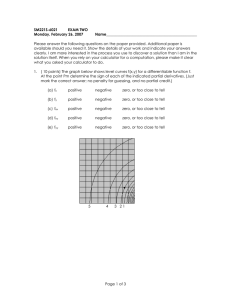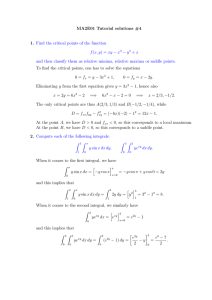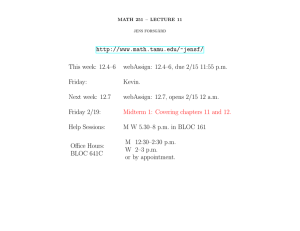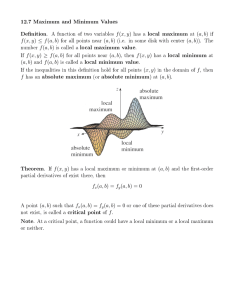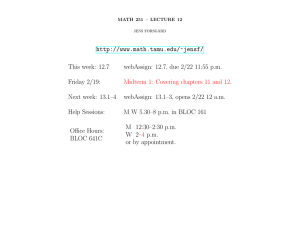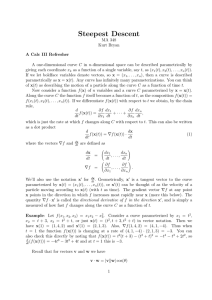Math 105 Assignment 8 Solutions 1. A farmer grows p
advertisement
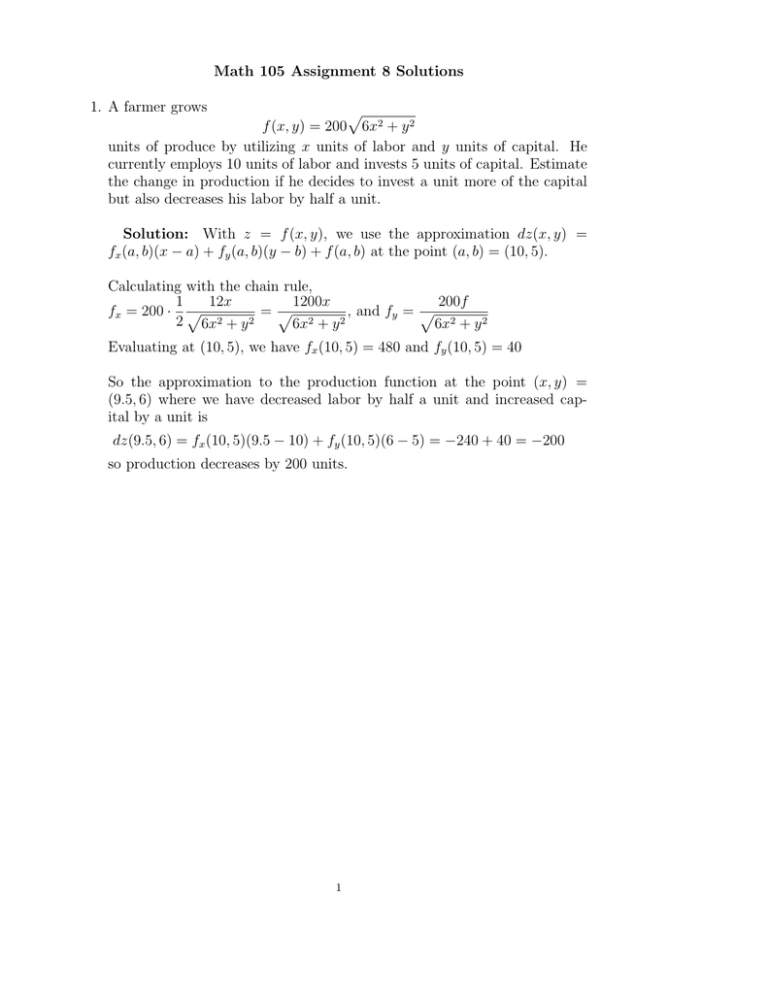
Math 105 Assignment 8 Solutions 1. A farmer grows p f (x, y) = 200 6x2 + y 2 units of produce by utilizing x units of labor and y units of capital. He currently employs 10 units of labor and invests 5 units of capital. Estimate the change in production if he decides to invest a unit more of the capital but also decreases his labor by half a unit. Solution: With z = f (x, y), we use the approximation dz(x, y) = fx (a, b)(x − a) + fy (a, b)(y − b) + f (a, b) at the point (a, b) = (10, 5). Calculating with the chain rule, 1 12x 1200x 200f fx = 200 · p =p , and fy = p 2 6x2 + y 2 6x2 + y 2 6x2 + y 2 Evaluating at (10, 5), we have fx (10, 5) = 480 and fy (10, 5) = 40 So the approximation to the production function at the point (x, y) = (9.5, 6) where we have decreased labor by half a unit and increased capital by a unit is dz(9.5, 6) = fx (10, 5)(9.5 − 10) + fy (10, 5)(6 − 5) = −240 + 40 = −200 so production decreases by 200 units. 1 2 2. For the function f (x, y) = ln(1 + xy), find the unit vector that gives the direction of steepest descent at the point P (2, 3). Also find the direction of no change at this point. Solution: The direction of the gradient ∇f tells us the direction of greatest increase, so to get the direction of steepest descent we need the direction of −∇f . y x 3 2 Calculating, ∇f = (fx , fy ) = , , and ∇f (2, 3) = , . 1 + xy 1 + xy 7 7 3 2 Thus −∇f (2, 3) = − , − . 7 7 √ p This vector has length (3/7)2 + (2/7)2 = 713 , so we divide by this length 1 to get the unit vector u = √ (3, 2) as the direction of steepest descent. 13 The direction of no change is a unit vector orthogonal to u. Noting that the unit vectors orthogonal to a unit vector (a, b) are (−b, a) and (b, −a), 1 we have that a direction of no change at the point (2, 3) is v = √ (−2, 3) 13 3 3. A monopolist markets a product in Canada and the UK and can charge different amounts in each country. Let x be the number of units to be sold in Canada and y the number of units to be sold in the UK. Due to the laws of demand and in order to sell all the units, the monopolist must set the unit price at 97 − (x/10) dollars in Canada and 83 − (y/20) dollars in the UK. The cost of production is $3 per unit, in addition to a base capital of $20,000. If the monopolist intends to maximize profit, how many units should he aim to sell in each country? Solution: First we need to write down the profit function. The monopolist sells x units in Canada at 97 − (x/10) for a profit of x(97 − (x/10)) and y units in the UK at 83 − (y/20) for a profit of y(83 − (y/20). The cost of production is 20, 000 + 3x + 3y. Thus our profit function is f (x, y) = x(97 − (x/10)) + y(83 − (y/20) − 3x − 3y − 20, 000 First we find critical points of this function by calculating the gradient. x y We have fx = 97 − − 3, fy = 83 − − 3. 5 10 Critical points are where these are both zero, which we can quickly solve to get x = 470, y = 800 as our only critical point. We still need to check whether this point is a maximum, minimum, or saddle point, so we need the second partial derivatives to find the discriminant. 1 fxx = − 15 , fyy = − 10 , fxy = 0 and the discriminant is D(x, y) = fxx fyy − 1 2 f xy = 50 > 0, which tells us that this point is either a maximum or minimum. Noticing fxx = (−1/5) < 0, this is a local maximum. Noting that no profit is made with x bigger than 97 · 10 and y bigger than 83 · 20, this must be a global maximum as well.

